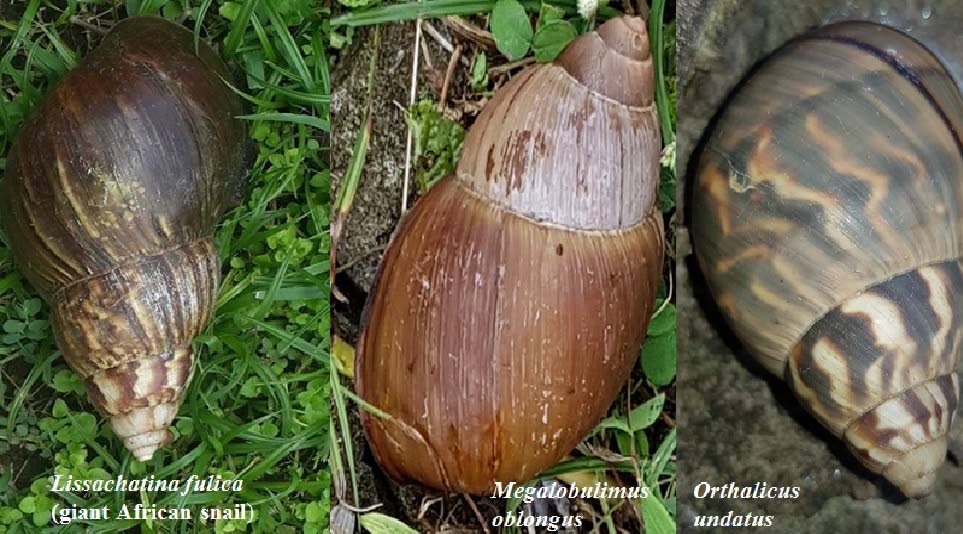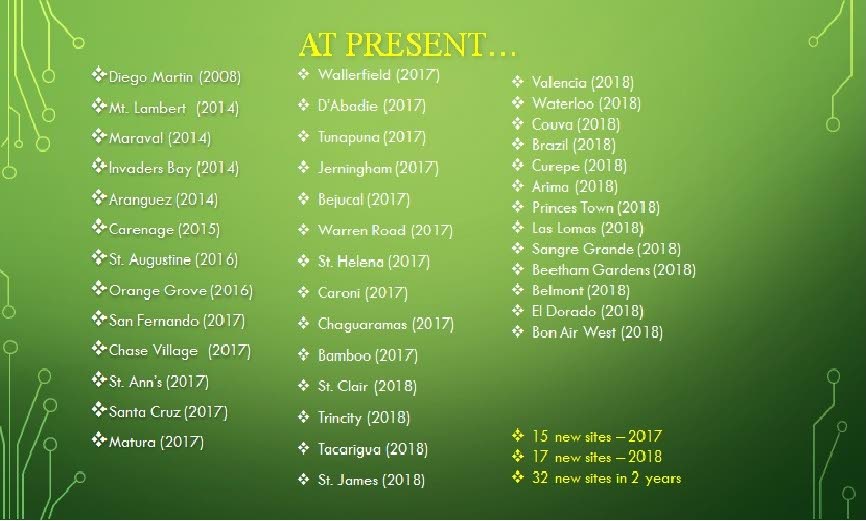Giant African snail invasion

They slide across the ground at night leaving trails of diseased slime, eating your plants and crops, and multiplying at an exponential rate.
Just two years ago, the giant African snail could only be found in seven places in Trinidad. Now, they are present in 39 areas across the island as far as Chaguaramas to the west to Matura to the east; Jerningham, Chase Village, and Caroni in Central; and St Joseph Village and Cedar Hill in south.
“That is the rate at which the snail has moved throughout the country. Therefore we are seeking the assistance of the public in managing this pest,” said Nazia Alishan, agricultural officer I with the Ministry of Agriculture, Land and Fisheries.
“The giant African snail programme initially started as an eradication programme in Diego Martin. However, in recent times, with the 32 new infestation sites, it has become more of a national issue. The programme was not sustainable as it was so we decided to switch to managing the problem. That is why we are asking citizens to try and play their part to assist us and work with us in trying to bring down the snail’s population to a more manageable level.”
She told Sunday Newsday, the snail is an invasive alien species, “meaning it is foreign and has the likelihood of just taking over,” and it has been in Trinidad since 2008. It has not reached Tobago.
But why should people be concerned and get rid of these pests?
Alishan explained the snail is a threat to agriculture as it feeds on over 500 species of plants including food crops, fruit, ornamentals, and forestry. It is also a vector for rat lungworm which can cause eosinophilic meningitis in humans, affecting the brain and spinal cord. She said people can become infected by inadvertently eating the eggs or hatchlings raw, such as in salads, or by the mucus getting into cuts in the skin.

In addition, the snail is very fertile. While local snails produce about 12 to 15 eggs a year, the giant African snail could lay from 900 to 1,200 eggs annually. She explained that after the first mating the snail is very fertile. It is also hermaphroditic therefore, it is capable of reproducing by itself. Because of that, they compete with local snails for space and food thereby threatening the existence of local snails.
“Our native snails play an integral part of the environment in terms of the nutrient cycle... For example the tree snail feeds on the bark of trees so it cleans the trees and allows the trees to breathe.”
And the snail is a possible threat to trade as it is listed as the second worst invasive alien species in the world and no one wants the pest in their country. She recalled several occasions where export of dirt, gravel, and similar materials was delayed while the buyers sent representatives to ensure the material was free of the snail and their eggs.
Recognise and eliminate
One of the main ways to distinguish the snail is by its shell. They are usually reddish brown in colour with pale yellow or cream vertical stripes running in one direction of the shell. Also the shells have more than six spirals or whorls.

Alishan said two local snails, the Megalobulimus oblongus and the tree snail (Orthalicus undatus), are often mistaken for the giant African snail. This, she said, is because the Megalobulimus is large, and the tree snail has stripes similar to the snail. However, she said the Megalobulimus is one solid colour, and the stripes of the tree snail are darker with a cross-band on the shell.
“In addition to that, you would rarely ever see just one giant African snail. With the local snails you may see one to three but with the giant African snail, I guarantee you, unless it’s a new infestation, there is no way you would see less than ten snails.”
She said while all snails are nocturnal, giant African snails are very active at night. They look for dark, moist places to hide during the day and, in residential areas, that is usually plants people have on their outside walls or fences. Local snails, she said, usually stay on the ground or on trees so frass or droppings on walls, or behind plants, is a good indicator that the snail is on the premises.
After the giant African snail has been identified, the next steps are to collect, kill, and dispose.
The most important thing is to first ensure that your hands are covered with a plastic bag or gloves before handling, and washed in warm, soapy water after. She also noted that the snails are “very hardy creatures” so a person should be sure they are dead before disposing of them.
She listed three ways to kill the snail and its eggs. They can be drowned by placing them in a solution of two cups of salt or bleach to one gallon of water, and cover the container for 24 hours.
Bait, which can be found at all agriculture stores, can also be used. Bait containing methaldehyde can be placed on the borders of farms or kitchen gardens, or placed in heaps, or mixed with vegetable scraps throughout an area. For those with children or pets, bait containing iron phosphate is recommended but still to be used with caution. For eggs and hatchlings, pesticides containing thiodicarb can be sprayed along the property.
After confirming that all the snails are dead, they can either be buried or placed in a double garbage bag to be disposed.
They can also be destroyed by burning the live or dead snails in a pit or metal barrel. She strongly advised that the fire be monitored, especially if it is being set during the dry season, and to ensure the snails are burnt to ashes.
Alishan warned people who are involved in buying plants and soil to pay attention to the areas they are moving the materials to and from, as the soil and potting mixtures can have snails or eggs.
She said the snails are hitch-hikers and can attach themselves to derelict vehicles, which when moved, can easily transport the snails to another part of the country. “For example, there are snails at Invaders Bay behind MovieTowne. So you may go out casually and a snail may crawl up on your vehicle and you are living Penal. That may be one way that the snail can go to an area that doesn’t have the snail. So people have to be mindful, especially farmers. Check your vehicles and equipment and keep them as clean as possible. You don’t want to be a means of transport for the snail.”
She also called on farmers to check their produce, making sure no snails are on the produce or lodged in creases, before taking it to the market. She also urged consumers to check their produce for snails before purchasing, and to thoroughly wash them before eating.
In an effort to create awareness, the ministry held its first Giant African Snail Awareness Week from December 3 to 7. It included a series of activities such as training workshops and exhibitions to educate the public on identification, prevention and control measures.
Anyone wishing to learn more or receive training can email snailreport@gmail.com or contact the giant African snail hotline at 646-6284.


Comments
"Giant African snail invasion"